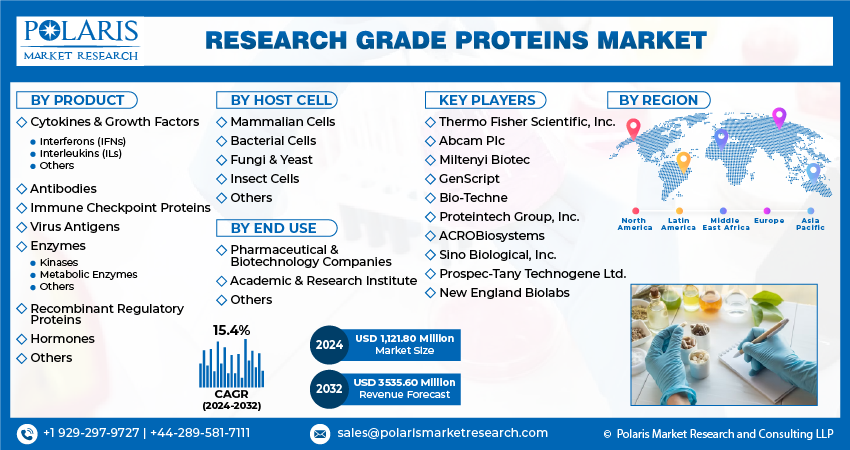Research Grade Proteins Market Size Worth $2,771.32 Million By 2034 | CAGR: 10.80%
The global research grade proteins market size is expected to reach USD 2,771.32 million by 2034, according to a new study by Polaris Market Research. The report “Research Grade Proteins Market Share, Size, Trends, Industry Analysis Report, By Product (Cytokines & Growth Factors, Antibodies, Immune checkpoint proteins, Virus Antigen, Enzymes, Others), By Host Cell (Mammalian Cells, Bacterial Cells, Others), By End-use, By Region, And Segment Forecasts, 2025 - 2034” gives a detailed insight into current market dynamics and provides analysis on future market growth.
Increasing investments in research and development in the field of cancer research, along with a rising demand for personalized medicines, are expected to be significant factors contributing to market growth. Additionally, government investments in various countries to support clinical studies are projected to drive market expansion. Furthermore, the biotechnology industry's ongoing advancements in developing nations are playing a crucial role in propelling market growth throughout the forecast period.
The market experienced a positive impact from the COVID-19 pandemic, driven by increased research efforts in vaccine, diagnostic, and therapeutic development. Regulatory authorities streamlined approval processes, leading to heightened demand for contract manufacturing services. While mRNA vaccines garnered attention, various recombinant protein vaccine alternatives were also under evaluation, contributing to the market's growth. For instance, In July 2022, Novavax, Inc. obtained expanded conditional marketing authorization for its Nuvaxovid recombinant protein-based COVID-19 vaccine in the EU. The pandemic underscored the necessity for adaptable biologics manufacturing capabilities, expected to enhance competition and drive market growth in the coming years.
Do you have any questions? Would you like to request a sample or make an inquiry before purchasing this report? Simply click the link below: https://www.polarismarketresearch.com/industry-analysis/research-grade-proteins-market/request-for-sample
Numerous regions have established biobanks through cohort programs, offering researchers high-quality samples to advance treatment methods. This is likely to lead to a heightened emphasis on discovering biomarkers for diverse conditions. Consequently, initiatives and governmental investments in research endeavors to strengthen healthcare infrastructure are anticipated to broaden the applications of research-grade proteins, fostering market expansion.
Producing proteins is a time-intensive task, demanding meticulous maintenance of operating conditions throughout. Despite the soaring demand for these recombinant products, regulatory support is advancing relatively slowly. Typically, research-grade proteins are created through a host or an expression system. In this method, the gene specific to the desired product undergoes transfection, bacterial transformation, or viral transduction stages. This intricate process often results in the over-expression of unintended regions and consumes additional time. Hence, the absence of precise guidelines and regulations for recombinant technology stands as a significant obstacle to the thriving market of research-grade proteins.

For Specific Research Requirements, Request for a Customized Research Report
Research Grade Proteins Market Report Highlights
- Cytokines held the largest share, owing to its rising need in clinical studies, drug discovery & development
- Mammalian cells segment dominated the market, primarily due to similar genetic make-up as humans, driving its usage in vaccines & monoclonal antibodies
- Pharmaceutical segment held the largest share, owing to rise in research activities for drug development & personalized medicines
- North America garnered the largest share, owing to presence of key players in the region, and robust medical infrastructure
- The key market players include Thermo Fisher Scientific, Abcam, Miltenyi Biotec, GenScript, Bio-Techne, Proteintech Group, and New England Biolabs
Polaris Market Research has segmented the research grade proteins market report based on product, host cell, end use, and region:
Research Grade Proteins, Product Type Outlook (Revenue - USD Billion, 2019 - 2032)
- Cytokines & Growth Factors
- Interferons (IFNs)
- Interleukins (ILs)
- Others
- Antibodies
- Immune Checkpoint Proteins
- Virus Antigens
- Enzymes
- Kinases
- Metabolic Enzymes
- Others
- Recombinant Regulatory Proteins
- Hormones
- Others
Research Grade Proteins, Host Cell Outlook (Revenue - USD Billion, 2019 - 2032)
- Mammalian Cells
- Bacterial Cells
- Fungi & Yeast
- Insect Cells
- Others
Research Grade Proteins, End Use Outlook (Revenue - USD Billion, 2019 - 2032)
- Pharmaceutical & Biotechnology Companies
- Academic & Research Institute
- Others
Research Grade Proteins, Regional Outlook (Revenue - USD Billion, 2019 - 2032)
- North America
- U.S.
- Canada
- Europe
- Germany
- UK
- France
- Italy
- Spain
- Russia
- Netherlands
- Asia Pacific
- China
- India
- Japan
- South Korea
- Indonesia
- Malaysia
- Latin America
- Argentina
- Brazil
- Mexico
- Middle East & Africa
- UAE
- Saudi Arabia
- Israel
- South Africa
Research Grade Proteins Market Report Scope
|
Report Attributes |
Details |
|
Market size value in 2024 |
USD 1,121.80 million |
|
Revenue forecast in 2032 |
USD 3535.60 million |
|
CAGR |
15.4% from 2024 – 2032 |
|
Base year |
2023 |
|
Historical data |
2019 – 2022 |
|
Forecast period |
2024 – 2032 |
|
Quantitative units |
Revenue in USD million and CAGR from 2024 to 2032 |
|
Segments covered |
By Product, By Host Cell, By End Use, By Region |
|
Regional scope |
North America, Europe, Asia Pacific, Latin America, Middle East & Africa |
|
Customization |
Report customization as per your requirements with respect to countries, region, and segmentation. |
|
For Specific Research Requirements |
License and Pricing
Purchase Report Sections
- Regional analysis
- Segmentation analysis
- Industry outlook
- Competitive landscape
Connect with experts
Suggested Report
- Pet Therapeutic Diet Market Future Scope, Global Report, 2025-2034
- Patient Access Solutions Market Demand, Growth Industry, 2025-2034
- Intraoperative Radiation Therapy Market Growth Drivers, Industry Report, 2025-2034
- Smart Home Energy Monitoring Devices Market Leading Companies, Drivers, 2025-2034
- Peripheral Nerve Stimulators Market Value and Revenue Estimations, 2025-2034
